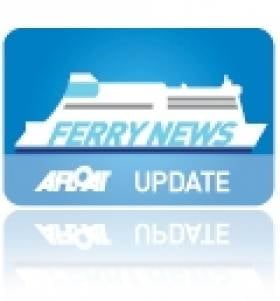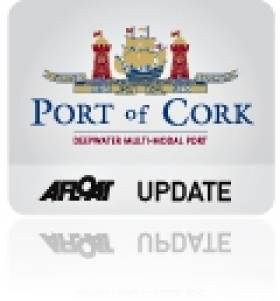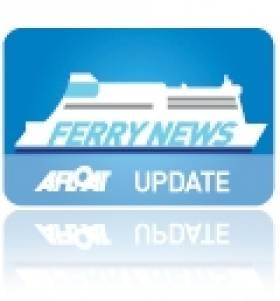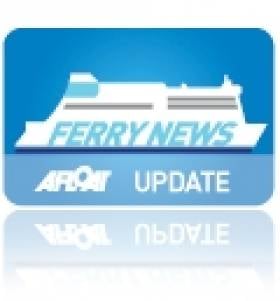Displaying items by tag: Ferry news
Belfast to Showcase Holiday World
#HOLIDAY WORLD SHOW -The Belfast Telegraph Holiday World Show will be officially opened by actress and comedian Crissy Rock of I'm a Celebrity... Get Me Out of Here' fame, where she is to 'check in' at the city's King's Hall, this Friday.
The three day show (20th -22nd January) which ends on the Sunday, is Northern Ireland's biggest annual public showcase of travel, tourism and hospitality will offer an array of holiday destinations. Around 30,000 visitors are expected to the show during the weekend.
It will also be the show's 20th anniversary, commenting on the milestone, organiser Edmund Hourican said: "In 2012 we'll be celebrating 20 years of Holiday World Belfast. While much has changed during that time, the event still provides would-be travellers with a hassle-free opportunity to find out about and compare destinations, airlines, travel agencies - and their prices.
"Today's savvy travellers understand that 'best value' doesn't necessarily mean 'cheapest'. Rather, they are looking to find the products and services that best match their requirements. While visitors to Holiday World Belfast are typically prepared to invest in holidays – often heavily - they do want reassurance that they are making the right choices and getting the best deal. The fact that Holiday World is packed with special offers and discounts is a welcome extra bonus!"
Following the popularity of last year's launch by Oasis Travel of the Cruise Pavilion, this part of the show is also to return in 2012, bringing the biggest names in cruising and will include the successful series of cruise lectures suited to both the experienced 'cruiser' and those completely new to this style of holiday.
In addition this year will feature an all new event-within-an-event Over 55s Holiday Show, adding an important new focus to Holiday World Belfast. To read more details of the show, exhibitors including ferry and cruise operators, and for opening times and admission prices click HERE.
Following the Belfast show, it will be the turn of Dublin to host the Holiday World Show in association with The Sunday Times which opens on the following weekend (Friday 27th-Sunday 29th January) in the RDS Simmonscourt Pavillon, Ballsbridge.
Like the Belfast show there will be an Over 55's Holiday Show plus the Caravan & Motorhome Show. For further details of the show they can be viewed HERE.
- Holiday World Show
- Ferry operators
- Cruise operators
- The Sunday Times
- Belfast Telegraph Holoiday World Show
- Kings Hall Belfast
- Oasis Travel
- Cruise Pavillon
- Cruiseliners
- RDS Dublin
- RDS Simmonscourt
- Ferry news
- Crissy Rock
- I'm a CelebrityGet me out of Here
- Irish travel firms
- Irish tourism
- Northern Ireland tourism
Ferry Operator Consider Court Finding
#FERRY NEWS – Senior managers in Stena Line are considering today the implications of a Labour Court recommendation that it increase redundancy terms for 39 workers at its Dún Laoghaire Harbour operation, the Irish Times reports.
The Labour Court rejected the workers' claim for automatic redeployment from the Dún Laoghaire service to Stena's Dublin Port – Holyhead route operation.
Stena's Dublin Port operation is managed by a subcontractor RoRo Services Dublin Ltd, which Stena said had no vacancies.
The ferry company has said the Dún Laoghaire -Holyhead service, which is now seasonal, will reopen in April, as previously reported on Afloat.ie. However, the company told the Labour Court there is currently no work for staff in the south Dublin port.
Workers who are members of SIPTU have been seeking redeployment to Dublin Port or enhanced redundancy payments.
However, while the Labour Court did recommend enhanced redundancy payments, the enhancement is less than that sought by the workers.
In previous redundancies at the company offered three weeks' pay per year of service, inclusive of statutory redundancy. In addition, they had received ex-gratia payments of €18,000 plus an additional €500 per year of service. The Labour Court recommended the €500 per year of service payment should be increased to €1,050 per year of service.
The Labour Court recommended that the company confirm staff in Dún Laoghaire would be given first call on jobs when the Dún Laoghaire service resumes in April.
A Stena spokesperson said senior management at the company were considering the recommendation and would make a statement later in the day.
Another Good Performance From Seatruck
#FREIGHT FERRY - The third of four newbuilds, Seatruck Performance was launched at the FGS Flensburg Yard, Germany, last week, according to The Motorship.
The first of the newbuildings, Seatruck Progress, is now operating on the Dublin-Liverpool route. The second in the series, Seatruck Power, will join this route in mid-February (see previous report HERE). The third vessel, Seatruck Performance, will begin operations in the Irish Sea in April and the final ferry will be launched at FSG at the end of March and is due to enter service in June.
All four ships will operate mainly in the Irish Sea. They are 142m long and 25m wide, boast a freight-carrying capacity of 2,166 lane-metres on four decks and can carry up to 155 trailers.
The FSG ships are the most efficient and modern in the Seatruck fleet, and will be the biggest to operate out of the port of Heysham, the length being determined by the size of this port.
FSG engineers designed the ships for eco-friendliness and low fuel consumption. Compared to conventional ships, they are said to consume up to 30% less fuel, saving costs and representing a significant contribution to environmental protection.
‘Resilient’ Performance by Port of Cork in 2011
#PORT OF CORK - Port of Cork Company chairman, Mr Dermot O'Mahoney, yesterday announced end of year trade traffic results for the Port of Cork in 2011. He said: "Trade traffic has shown remarkable resilience recording 8.8 million tonnes despite experiencing challenging periods during 2011." These figures are on a par with 2010 figures at the Port of Cork.
A remarkable feature of the figures is the very positive effect on the local economy by the increase in exports from the Port. Total exports at the Port of Cork have remained strong increasing by 9% in comparison to 2010 and by 19% since 2009. Exports are a key driver in the successful recovery of the Irish Economy and the Port of Cork is committed to continuous support in the growth of international trade for both current and future economic prospects.
Although the growth in export volumes to pre –recession levels reflects the rapid "V" shaped bounce back by the export sector which was achieved despite the depressed international economic environment, import volumes are still 12.9% below 2007 levels. The continued low volume of imports is inevitably putting huge strain on the ports, shipping lines and transport sector servicing the country.
The container business at the Port of Cork has shown an increase of 5% with over 150,000 TEU handled in 2011. Animal feed stuffs, fertiliser and other trades have shown a marginal decrease in 2011. Oil traffic has remained steady despite the lower levels of domestic economic activity; however exports of refined product from Conoco Phillips Whitegate Oil Refinery has remained strong and continues to be a significant part of the Port of Cork business.
Remarking on the end of year trade traffic results, Mr Dermot O'Mahoney Chairman of the Port of Cork said: "The Port of Cork is pleased to announce that total trade traffic in 2011 has remained strong with exports increasing by 9% over 2010 volumes. With 98% of all goods imported or exported from Ireland moved by ship, the importance of ports to our economy is of vital strategic importance. The Port of Cork is a key link to the continued economic success of Ireland and in particular the entire Munster region. The challenge now facing the Port of Cork is to continue to develop to meet the needs of the Country as it emerges from this current recession. This requires that we be visionary and seize opportunities presented by emerging trends and logistic supply changes."
He continued: "While the next four to five years will be challenging for us all, we need to continue to promote the fact that Ireland is an excellent investment location and is well placed to capitalise on growing global markets as is evident by our export sector."
53 cruise vessels visited the Port of Cork during 2011 bringing over 100,000 passengers and crew to the region and the Port is scheduled to accommodate 60 vessels in 2012. According to research carried out by UK Consultants GP Wild, the average in-transit spend per passenger, while visiting an Irish port is between €73- €100 which provides a significant contribution towards the local tourism economy. In 2011 the Port of Cork won 1st place for 'Best Destination Experience (Organised)' in the world and 2nd place for 'Best Port Welcome' in the Dream World Cruise Destinations Awards. This achievement highlighted the outstanding team effort and commitment by the Port of Cork to deliver an excellent service to the visiting cruise lines and their passengers when in Cork. Ireland Inc. also received a Commendation as a "Destination where the Quality and Professionalism of Tour Guides is considered outstanding".
Port officials are pro-actively engaged with tourism interests, County and City Councils and destination attractions to enhance the product on offer to the visiting cruise lines with a view to growing the business further through its dedicated cruise terminal.
Ferry passenger numbers with Brittany Ferries remained steady on its weekly ferry service from Cork to Roscoff and the Port awaits the outcome of the Examinership of Fastnet Lines and the re-commencement of the ferry service linking Cork with Swansea.
The Port of Cork's recreational strategy continues to expand with the aim of improving the marine leisure facilities around Cork Harbour.
Mr O' Mahoney concluded by saying that "the Port of Cork must continue to reinforce its existing strength as the primary deep-water port in the south of Ireland and build on our progress so far by effectively resolving our challenges in an imaginative way and with a strong sense of urgency and determination."
New Dates for National Ferry Fortnight
#FERRY FORTNIGHT - This year's 'National Ferry Fortnight' organised by the Passenger Shipping Association is to be brought forward in March instead of May, according to TravelWeekly.co.uk.
The annual event which is used to promote and increase awareness of the UK ferry industry has set the new dates of the fortnight between the 17th-31st March.
According to the PSA the change of dates was designed to "emphasise the great value of family ferry travel at a time when parents have a watchful eye on budgets".
PSA which also represents the UK cruise sector had 13 ferry members but SeaFrance, a Dover-Calais operator recently went into administration.
A new official logo will front the campaign which is supported by all ferry line members of the association. The two week showcase aims to heighten consumer and media awareness of the UK's more than 50 ferry routes.
PSA members including Brittany Ferries, Condor Ferries, DFDS Seaways, Hovertravel, Isle Of Man Steam Packet Company, Irish Ferries, LD Lines, P&O Ferries, Red Funnel, Stena Line and Wightlink will take part.
It comes as the association estimated that around 35 million people, 8 million cars and 140,000 coaches were carried by ferries in 2011.
A series of promotional offers on ferry routes are planned as part of the campaign, to the Continent, Spain, Ireland and UK islands which promoted on the discoverferries.com website.
PSA director Bill Gibbons said: "Particularly for families, Britain's ferry services offer a reliable and flexible way to travel that's good value for money.
"Our ferry members are keen to bring forward the success of National Ferry Fortnight to March 2012 so families can plan and take advantage of the great range of opportunities presented by ferry companies."
Bad Weather Continues to Disrupt Ferry Sailings
#FERRIES - As the adverse weather continues, ferry services across the Irish Sea remain affected, with several crossings cancelled, writes Jehan Ashmore.
Irish Ferries 08.05hrs sailing this morning from Dublin to Holyhead operated by Isle of Inishmore, departed over three hours later than her scheduled time.
Last night she had just been deployed on the route so to cover sailings usually operated by Ulysses, which went off-service for annual dry-docking at Cammell Laird, Birkenhead, as previously reported on Afloat.ie
In addition the fast-ferry craft sailing at 08.45hrs from Dublin Port served by the Jonathan Swift were cancelled and the following sailings are also cancelled:
Dublin -Holyhead 14.30hrs
Holyhead-Dublin 12.00hrs AND 17.15hrs
Passengers booked on the Jonathan Swift instead will be accommodated on the Isle of Inishmore. For further information on Dublin-Holyhead sailing updates click HERE.
On the Rosslare-Pembroke Dock service, sailings were too cancelled with last night's sailing from Wales, which are currently served by Oscar Wilde. She sailed as scheduled with this morning's 08.45hrs sailing to Pembroke Dock.
To keep updated on Rosslare-Pembroke Dock sailings click HERE.
For further information, Irish Ferries Central Reservations contact: 0818 300 400 and for Irish Ferries, Rosslare Harbour contact: 00353 53 9133158
STENA LINE
For information on sailing schedules and updates from the company's Ferrycheck facility click HERE.
To contact Stena Line call: 003531 204 77 99 when travelling to Britain or 0044 (0) 8705 755 755 when travelling to Ireland or Scotland
P&O FERRIES
Dublin to Liverpool sailing at 1500hrs is cancelled and passengers will be accommodated on either 2130hrs tonight or 0900hrs on Friday 6th January.
For other sailings and on the Larne-Cairnryan click HERE and to contact +44 (0) 871 66 44 777 if calling from UK
OR (01) 407 34 34 if calling from ROI. In addition to latest sailing infomation on +44 (0)845 832 8888
FOR OTHER FERRY OPERATORS
Please click this LINK and choose the relevant highlighted ferry route for further information.
Dublin Route Reduced to Single-Ship Service
#FERRIES – Stena Line's two-ship operated Dublin-Holyhead route is to be reduced to a single vessel service as from tomorrow, due to annual dry-docking requirements, writes Jehan Ashmore.
Stena Nordica (2000/24,206grt) is to go off the route for a refit from 5th-19th January. The last sailing scheduled for the ferry will be from Dublin Port at 02.15hrs on 5th January. She is scheduled to return on the 3 hour 15 minute route on 19th January with the 16.00hrs sailing from the capital.
Fleetmate Stena Adventurer will continue operating to her normal schedule while the Japanese ro-pax vessel is away for the dry-docking period. For information on route sailings schedules click HERE.
During the off-peak winter season, particularly during the months of January and February, it is common practice for ferry operators to take vessels off-service for annual dry-docking.
In addition to Stena Line, rivals Irish Ferries today started a fleet logistic operation as vessels are taken off and on routes for dry-docking and replaced with temporary tonnage, as previously reported on afloat.ie
Ferry Go-Round
# FERRY NEWS - Irish Ferries French routes cruiseferry Oscar Wilde (1987/31,914grt) took over Rosslare-Pembroke Dock sailings with this morning's sailing, instead of the usual route vessel that operates on the southern corridor route, writes Jehan Ashmore.
Currently there are no services running to Cherbourg until February, though Oscar Wilde is covering in for the Welsh route ferry Isle of Inishmore (1997/31,031grt). She in turn is due to relief Dublin-Holyhead sailings from tonight on the route which is normally served by flagship Ulysses (2001/50,938grt) which heads off for dry-docking.
In the meantime Isle of Inishmore is in Rosslare after completing last night's sailing from the Pembrokeshire port. She is due to make a repositioning voyage with an arrival into Dublin Port this evening and followed by a brief turn-around at the ferryport, she is take over the route's roster with tonight's 20.55 crossing to Holyhead.
Seatruck Newbuild Making Progress On Irish Sea
#FERRY NEWS -Seatruck Ferries newbuild freight-only ferry, Seatruck Progress carried out berthing trials in Dublin Port yesterday in preparation to her debut on the Liverpool route over the festive period, writes Jehan Ashmore.
This was the inaugural call to the capital, though she had sailed across Dublin Bay earlier this month (as previously reported - click HERE) during her delivery voyage to Liverpool from German shipbuilders FGS Flensburger.
At 142 metres long and with a beam of 24 metres, the four decked ro-ro vessel, offers more capacity to the routes existing pair of 'Point' class vessels, as she can handle an extra 35 trailer units (each of 13.5m) than the Clipper Point and Clipper Pennant.
In February, the newcomer's second sister out of four on order, Seatruck Power is set to join her on the central corridor route.
Seatruck are the only Irish Sea operator dedicated to the carriage of un-accompanied freight traffic, though the vessels can cater for driver accompanied units with a limited number of cabins.
Former B+I Line Freight-Ferry Bound for Turkish Breakers
#FERRY NEWS-P&O Irish Sea's Larne-Troon freight-ferry Norcape (14,087grt) departed the Co. Antrim port last week to be broken-up at ship-breakers in Aliaga, Turkey. She originally served B+I Line as the Tipperary, but her last sailings took place on the North Channel in late November, as the ageing vessel is in her fourth decade of service, writes Jehan Ashmore.
The 125-trailer capacity ro-ro was not replaced on the single-ship operated route which closed for the winter months, though sailings will resume next March by the 92m fast-ferry Express. In the meantime freight traffic will be accommodated on the companies Larne-Cairnryan service.
Yesterday morning Norcape transitted the Strait of Gibraltar having called en-route to Falmouth several days previously. She represented the last vessel to serve in Irish waters with a direct link to B+I Line, the state-owned operator which was sold in 1992 to ICG, parent company of Irish Ferries.
When she arrives in Aliagra, this is where her former P&O fleetmate European Mariner (5,897grt) was scrapped after also serving Larne-Troon sailings until last July. Norcape entered the North Channel route replacing the smaller 53-trailer capacity vessel.
Prior to then Norcape had been in laid-over in Liverpool docks when European Endeavour replaced her in February on the Dublin-Liverpool route. To read more click HERE.
Norcape's return to the Irish Sea service in 2009, reflected her original career for P&O. She was named Puma in 1979 from the Japanese shipyard at the Mitsui Engineering & SB Co Ltd, Tamano, however she was chartered to B+I Line and renamed Tipperary. To read more and to view a deck-drawing profile, click HERE.
Her career started with a new Dublin-Fleetwood route jointly operated with P&O, who contributed with a sister, the Ibex. The P&O brand name Pandoro stood for P and O Ro, their roll-on roll-off freight division. The route's UK port switched to Liverpool in 1988 with Tipperary remaining on the route until sold to North Sea Ferries in 1989 and renamed Norcape.
Before her transfer to the North Sea, Tipperary collided with the 4,674grt bulker Sumburgh Head off the entrance to Dublin Port in 1988. Incidentally the two vessels, under different names and ownership were in Dublin Port in 2010, as previously reported (with photo) click HERE.
- Ports and Shipping News
- Norcape
- P&O (Irish Sea)
- B+I Line
- European Endeavour
- Ferry news
- Irish Sea Ferries
- Irish Sea ferry news
- LarneTroon
- MV Tipperary
- Turkish shipbreakers
- P&O Express
- MV Ibex
- Pandoro
- Aliagra,Turkey
- MV Norcape
- ICG
- ICG Group
- Irish Continental Line
- North Channel ferry routes
- LarneCairnryan
- Irish Ferries






































































